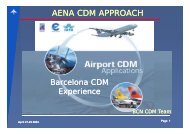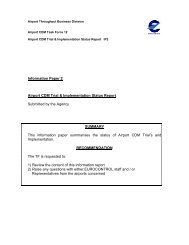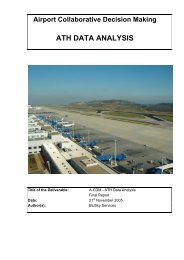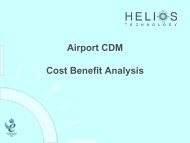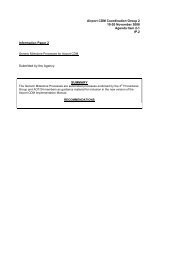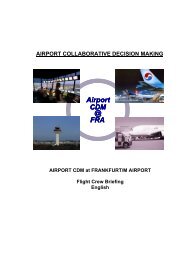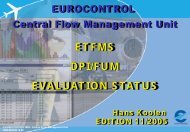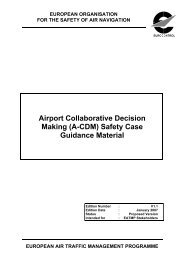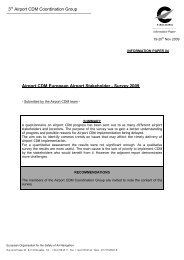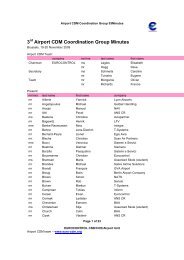AIC IFR 5_10.fm - Airport Collaborative Decision Making
AIC IFR 5_10.fm - Airport Collaborative Decision Making
AIC IFR 5_10.fm - Airport Collaborative Decision Making
Erfolgreiche ePaper selbst erstellen
Machen Sie aus Ihren PDF Publikationen ein blätterbares Flipbook mit unserer einzigartigen Google optimierten e-Paper Software.
BUNDESREPUBLIK DEUTSCHLAND<br />
FEDERAL REPUBLIC OF GERMANY<br />
DFS Deutsche Flugsicherung GmbH (German Air Navigation Services)<br />
Büro der Nachrichten für Luftfahrer (Aeronautical Publication Agency)<br />
Am DFS-Campus 10 · 63225 Langen · Germany<br />
Tel. + 49 6103 707 - 12 71/12 72 · Telefax + 49 6103 707 - 12 96<br />
www.dfs-aviationshop.de · e-mail: redaktion.aip@dfs.de<br />
Probebetrieb <strong>Airport</strong>-CDM am Verkerhrsflughafen<br />
Frankfurt/Main (EDDF)<br />
1. Allgemeines<br />
Anlässlich der europäischen Aktivitäten zu <strong>Airport</strong> <strong>Collaborative</strong><br />
<strong>Decision</strong> <strong>Making</strong> (<strong>Airport</strong>-CDM) wurde der Umdrehprozess<br />
(Turn-round) am Flughafen Frankfurt/Main neu gestaltet.<br />
<strong>Airport</strong> CDM ist der harmonisierte operationelle Ansatz zur Abwicklung<br />
eines optimalen Umdrehprozesses. Das Verfahren umfasst<br />
den Zeitraum Estimated Off Block Time (EOBT) minus 3 Stunden bis<br />
Take-Off und ist ein durchgehender Prozess von der Flugplanung<br />
(ATC-Flugplan) über Landung und Umdrehprozess am Boden bis<br />
zum Start.<br />
<strong>Airport</strong>-CDM am Verkehrsflughafen Frankfurt/Main basiert auf dem<br />
europäischen Standard für <strong>Airport</strong>-CDM, sowie der Initiative "Deutsche<br />
Harmonisierung von <strong>Airport</strong>-CDM".<br />
Resultierend aus qualitativ besseren Informationen zu In- und Outbound<br />
wurde die Prozesskette von der Landung bis zum Start optimiert.<br />
Diese Optimierung mündet in die "Target Start-Up Approval<br />
Time (TSAT)", der Zeit, zu der ein Luftfahrzeug spätestens die Anlassfreigabe<br />
erhält. Die TSAT ist der wesentliche Faktor zur Erstellung<br />
einer "Pre-Departure Sequence" unter Berücksichtigung der<br />
Belange aller beteiligten Partner.<br />
Um das lokale <strong>Airport</strong>-CDM-Verfahren optimal in das europäische<br />
Verkehrsflussmanagement (ATFCM) einzubinden, wird ein permanenter<br />
und voll automatisierter Datenaustausch mit der Central Flow<br />
Management Unit (CFMU) eingeführt. Hieraus ergeben sich sowohl<br />
frühzeitig verlässliche Vorhersagen der Lande- bzw. In-Block-Zeit,<br />
als auch eine bessere Zuweisung der Calculated Take Off Time<br />
(CTOT).<br />
1.1 Beginn des Probebetriebes<br />
Nach eingehenden Tests der Systemumgebung wird der Probebetrieb<br />
am 3. November 2010 beginnen.<br />
Gleichzeitig werden die operativen Verfahren von <strong>Airport</strong>-CDM eingeführt.<br />
Ab 3. November 2010 (0300) gelten für alle <strong>IFR</strong>-Flüge am Flughafen<br />
Frankfurt/Main die folgenden Verfahren:<br />
2. Verfahren<br />
2.1 Flugplanüberprüfung<br />
Eingehende ATC-Flugpläne für Abflüge werden in Hinblick auf ihren<br />
<strong>Airport</strong> Slot - Scheduled Off-Block Time (SOBT) - überprüft. Die Estimated<br />
Off-Block Time (EOBT) muss mit der SOBT übereinstimmen.<br />
Bei Abweichungen erfolgt eine Information an die entsprechende<br />
Kontaktadresse, mit der Aufforderung, die Zeiten anzugleichen.<br />
2.2 Target Off-Block Time (TOBT)<br />
Die TOBT ist die Orientierungszeit für alle Abfertigungsprozesse,<br />
außer Push-back und Luftfahrzeugenteisung. Sie wird als beste verfügbare<br />
Zeit für die Koordination verwendet.<br />
TOBT = Vorhersage des "Aircraft Ready".<br />
Trial Operations <strong>Airport</strong> CDM at<br />
Frankfurt/Main <strong>Airport</strong> (EDDF)<br />
<strong>AIC</strong> <strong>IFR</strong><br />
<strong>AIC</strong> <strong>IFR</strong><br />
5<br />
21 OCT 2010<br />
1. General<br />
The turn-round process at Frankfurt/Main <strong>Airport</strong> has been reorganized<br />
on the basis of the European activities concerning <strong>Airport</strong> <strong>Collaborative</strong><br />
<strong>Decision</strong> <strong>Making</strong> (A-CDM).<br />
<strong>Airport</strong> CDM facilitates the optimal handling of turn-round processes<br />
in operations at Frankfurt/Main <strong>Airport</strong>. It covers the period of time<br />
between the estimated off-block time (EOBT) minus 3 hours and<br />
take-off and is a coherent process from flight planning (ATC flight<br />
plan) to landing and the subsequent turn-round process on the<br />
ground before the next take-off.<br />
<strong>Airport</strong> CDM at Frankfurt/Main <strong>Airport</strong> is based on the European<br />
standard for <strong>Airport</strong> CDM and the initiative "Deutsche Harmonisierung<br />
von <strong>Airport</strong> CDM".<br />
The improved quality of the inbound and outbound information was<br />
used to optimise the process chain from arrival to departure. This optimisation<br />
has led to a "Target Start-Up Approval Time (TSAT)", i.e.<br />
the time at which an aircraft is issued start-up approval at the latest.<br />
This TSAT is an essential factor for the preparation of a "Pre-Departure<br />
Sequence" which takes the requirements of all parties involved<br />
into account.<br />
A continuous and fully automated data exchange with the Central<br />
Flow Management Unit (CFMU) has been implemented to connect<br />
the local <strong>Airport</strong> CDM procedure with the European air traffic flow<br />
and capacity management (ATFCM) in the best possible manner.<br />
Due to this process, reliable forecasted landing and in-block times<br />
can be given earlier and the assignment of the calculated take-off<br />
time (CTOT) is enhanced.<br />
1.1 Start of trial operations<br />
Following extensive tests of the system environment, trial operations<br />
will start on 3 November 2010.<br />
At the same time, the operational procedures of <strong>Airport</strong> CDM will be<br />
implemented.<br />
As of 3 November 2010 (0300) the following procedures apply to all<br />
<strong>IFR</strong> flights at Frankfurt/Main <strong>Airport</strong>:<br />
2. Procedures<br />
2.1 Flight plan validation<br />
Incoming ATC flight plans for departures are validated with regard to<br />
their airport slots, i.e. the scheduled off-block times (SOBT). The<br />
estimated off-block time (EOBT) shall correspond to the SOBT.<br />
If the SOBT deviates from the EOBT, the relevant contact person will<br />
be informed and advised to adjust the times accordingly.<br />
2.2 Target Off-Block Time (TOBT)<br />
TOBT is a reference time used for all ground handling processes except<br />
for aircraft push-back and de-icing. This time is used for coordination<br />
since it is the best available time for that purpose.<br />
TOBT = prediction of "Aircraft Ready"<br />
bitte wenden / p.t.o.
Seite 2 von 4 / Page 2 of 4<br />
21 OCT 2010<br />
2.2.1 Automatisch erzeugte TOBT<br />
30 Minuten vor der Estimated Landing Time (ELDT) generiert das<br />
System automatisch eine TOBT, falls diese nicht zuvor bereits manuell<br />
gesetzt wurde (frühestens 90 Minuten vor EOBT möglich).<br />
Die automatisch generierte TOBT wird unter Berücksichtigung der<br />
Estimated In-Block Time (EBIT), Minimum Turn-round Time (MTTT)<br />
sowie der CTOT erzeugt.<br />
Es findet keine Unterscheidung von direktem Umlauf und Flügen mit<br />
längerer Standzeit, die ggf. umgeschleppt werden, statt.<br />
2.2.2 TOBT-Verantwortung<br />
Nach automatischer Generierung der TOBT ist der Abfertigungsagent,<br />
die Luftfahrtgesellschaft (für Flüge ohne Abfertigungsagenten)<br />
oder der verantwortliche Pilot (für Flüge der Allgemeinen<br />
Luftfahrt ohne Abfertigungsagenten) für die Korrektheit und Einhaltung<br />
der TOBT verantwortlich.<br />
Ist erkennbar, dass die TOBT nicht eingehalten werden kann, muss<br />
sie korrigiert bzw. neu eingegeben werden. Da die TOBT auch weitere<br />
Prozesse am Flughafen steuert, sind Anpassungen der TOBT<br />
von mehr als 5 Minuten (auch Verfrühungen) durch den TOBT-Verantwortlichen<br />
einzugeben.<br />
Bei Abweichung von der EOBT um 15 Minuten und mehr besteht<br />
weiterhin die Verpflichtung, eine Verspätungsmeldung (DLA) an die<br />
CFMU zu schicken.<br />
2.2.3 TOBT Korrektur/Löschung<br />
Eine Korrektur der TOBT kann bis zur Ausgabe der TSAT (TOBT<br />
minus 40 Minuten) beliebig oft vorgenommen werden. Nach Ausgabe<br />
der TSAT kann die TOBT maximal dreimal korrigiert werden, eine<br />
vierte Korrektur ist nicht möglich, die TOBT muss dann gelöscht und<br />
neu eingegeben werden. Die neue TOBT muss mindestens 5 Minuten<br />
später als der aktuelle Zeitpunkt liegen.<br />
Soll ein Flug aus der TOBT- bzw. TSAT-Berechnung herausgenommen<br />
werden, ist die TOBT über die beschriebenen Meldewege zu löschen.<br />
Um diese Prozessunterbrechung wieder aufzuheben, ist<br />
durch die Luftverkehrsgesellschaft ggf. eine Verspätungsmeldung<br />
(DLA) zu veranlassen. Durch den TOBT-Verantwortlichen ist die<br />
TOBT neu einzugeben.<br />
Bei Wechsel des Luftfahrzeugs und entsprechend erfolgter Änderungsmeldung<br />
(CHG - Type/Registration) wird die ursprüngliche<br />
TOBT beibehalten.<br />
2.2.4 TOBT-Dialog<br />
Der TOBT-Dialog erfolgt über einen der nachstehenden Meldewege:<br />
– Common Situational Awareness Tool (CSA-Tool)<br />
– Internes System der Luftfahrtgesellschaft/des Abfertigungsagenten<br />
(über Schnittstelle)<br />
– SITA: FRAAF7X<br />
– Fraport-Verkehrsdatenzentrale nach telefonischer Anfrage:<br />
Tel.: +49 69 690 71740<br />
Für Flüge der Allgemeinen Luftfahrt :<br />
– Bei Fraport Executive Aviation Services in das CSA-Tool:<br />
Tel.: +49 69 690 71718/71719<br />
– SITA: FRAAG7X<br />
2.3 Target Start-up Approval Time (TSAT)<br />
Die TSAT ist die Zielzeit für die Erteilung der Anlassfreigabe gemäß<br />
A-CDM-Verfahren. Die Berechnung der TSAT erfolgt frühestens 40<br />
Minuten vor TOBT. Die "Pre Departure Sequence" ergibt sich aus<br />
den Flügen mit berechneter TSAT.<br />
2.3.1 TSAT-Übermittlung<br />
Die Übermittlung der TSAT erfolgt über einen der folgenden Wege:<br />
– CSA-Tool<br />
– Schnittstelle für z. B. Airline- oder Ground Handler Systeme<br />
– Systeme der Vorfeldkontrolle<br />
– Systeme des Towers<br />
– Datalink Clearance (DCL)<br />
– Short Message Service (SMS)<br />
Für Flüge der Allgemeinen Luftfahrt :<br />
– CSA-Tool<br />
<strong>AIC</strong> <strong>IFR</strong><br />
5<br />
LUFTFAHRTHANDBUCH DEUTSCHLAND<br />
AIP GERMANY<br />
2.2.1 Automated TOBT<br />
30 minutes before Estimated Landing Time (ELDT), the system automatically<br />
generates a TOBT if the TOBT has not been set before<br />
manually (this is possible up to 90 minutes prior to EOBT).<br />
The automated TOBT is calculated on the basis of the Estimated In-<br />
Block Time (EBIT), minimum turn-round time (MTTT), and CTOT.<br />
This also applies to the calculation of the TOBT for aircraft which are<br />
not part of a direct turn-round and which do not park on their outgoing<br />
position.<br />
2.2.2 Person responsible for TOBT<br />
Once the TOBT has been generated, the handling agent, the airline<br />
(for flights without handling agents) or the pilot-in-command (for<br />
General Aviation flights without handling agent) is responsible for<br />
TOBT correctness and adherence.<br />
If it becomes obvious that the TOBT cannot be respected, it shall be<br />
corrected or re-entered by the person responsible for the TOBT.<br />
Since the TOBT is used for various ground processes, it shall be updated<br />
by the person responsible for TOBT when deviations of more<br />
than 5 minutes (+/-) become obvious.<br />
For deviations of 15 minutes or more, it will still be mandatory to send<br />
a delay message (DLA) to the CFMU.<br />
2.2.3 TOBT update/deletion<br />
Until issue of the TSAT (TOBT minus 40 minutes), updates of the<br />
TOBT are not limited in number. After the TSAT has been issued,<br />
the TOBT can be updated up to three times. Thereafter, the TOBT<br />
shall be deleted and a new TOBT shall be sent. The new TOBT shall<br />
be at least 5 minutes later than the current time.<br />
If a flight is to be taken out of the TOBT/TSAT calculation, the TOBT<br />
is to be deleted by way of the reporting routines described. The airline<br />
operator may have to initiate a delay message (DLA) in order to<br />
undo such a process interruption. The TOBT shall be re-entered by<br />
the person responsible for the TOBT.<br />
If the aircraft is changed, a change message (CHG - type/registration)<br />
shall be sent. In this case, the TOBT remains in effect and is allocated<br />
to the new aircraft.<br />
2.2.4 TOBT reporting routines<br />
The TOBT is reported and/or adjusted in one of the following ways:<br />
– Common Situational Awareness Tool (CSA tool)<br />
– Internal system of the airline/handling agent (via interface)<br />
– SITA: FRAAF7X<br />
– By telephone via the Fraport Traffic Data Centre:<br />
Tel.: +49 69 690 71740<br />
For General Aviation flights:<br />
– Via Fraport Executive Aviation Services in the CSA tool:<br />
Tel.: +49 69 690 71718/71719<br />
– SITA: FRAAG7X<br />
2.3 Target start-up approval time (TSAT)<br />
The TSAT is the target time for start-up approval according to the<br />
A-CDM procedure. The earliest time for the TSAT calculation is 40<br />
minutes prior to TOBT. The "Pre-Departure Sequence“ is a result of<br />
the calculated TSATs.<br />
2.3.1 TSAT reporting routines<br />
The TSAT is transmitted in one of following ways:<br />
– CSA tool<br />
– Interface for e.g. the airlines' or ground handling agents' systems<br />
– Systems used by apron control<br />
– Systems used by the ATC tower<br />
– Datalink Clearance (DCL)<br />
– Short Message Service (SMS)<br />
For General Aviation flights:<br />
– CSA tool<br />
© DFS Deutsche Flugsicherung GmbH
LUFTFAHRTHANDBUCH DEUTSCHLAND<br />
AIP GERMANY<br />
TSAT bzw. TSAT-Änderungen werden grundsätzlich an den TOBT-<br />
Verantwortlichen übermittelt und von diesem an die Flight Crew/Piloten<br />
weiter gegeben. Bei Freigabevorgängen über Datalink (DCL)<br />
wird die TSAT zusätzlich direkt ins Cockpit übermittelt.<br />
SMS Service:<br />
Zur Abfrage einer TSAT, sendet der Nutzer eine SMS mit dem<br />
Schlüsselwort TSAT und der IATA-Flugnummer (commercial callsign)<br />
an die folgende Telefonnummer: +49 173 72 85 018.<br />
Die Registrierung für einen Flug kann frühestens eine Stunde vor<br />
Abflug erfolgen. Nach erfolgreicher Registrierung erhält der Nutzer<br />
die aktuelle TSAT und TOBT. Alle TSAT-Updates > 5 Minuten und<br />
alle TOBT-Updates werden automatisch übermittelt. Das letzte Update<br />
erfolgt zum Zeitpunkt TSAT minus 5 Minuten. Bei fehlgeschlagener<br />
Registrierung, erhält der Nutzer eine Hinweis-SMS wie er zu<br />
verfahren hat.<br />
Hinweis: Bitte beachten, dass eine TSAT erst zum Zeitpunkt TOBT<br />
minus 40 Minuten vorliegt.<br />
2.3.2 TOBT und TSAT in Extremsituationen<br />
Sofern TOBT und TSAT um mehr als 90 Minuten voneinander abweichen,<br />
muss zum Zeitpunkt TOBT der Abfertigungsprozess abgeschlossen<br />
sein. Hiervon ausgenommen ist in diesen<br />
Extremsituationen jedoch das Boarding der Passagiere. Dieses<br />
muss spätestens zum Zeitpunkt TSAT minus 30 Minuten abgeschlossen<br />
sein.<br />
2.4 Start-up und Push-Back<br />
Die Freigaben für Start-up und Push-back erfolgen ausschließlich<br />
unter Berücksichtigung von TOBT und TSAT. Die Reihenfolge des<br />
Start-up Request spielt keine Rolle mehr. Es gelten folgende<br />
Regeln:<br />
– Mit Erreichen des Zeitpunkts TOBT muss das Luftfahrzeug fertig<br />
für Start-up bzw. zur Vorfeldenteisung sein<br />
– Die Anfrage zur Erteilung der Anlass- und Streckenfreigabe muss<br />
im Zeitraum TSAT -/+ 5 Minuten erfolgen (nicht bei DCL)<br />
– In Abhängigkeit von der TSAT und der Verkehrssituation erteilt<br />
Clearance Delivery die Anlass- und Streckenfreigabe<br />
– Spätestens 5 Minuten nach Erhalt der Anlassfreigabe muss die<br />
Anfrage für Push-back/Taxi erfolgen<br />
Bei Verzögerungen ist Clearance Delivery zu informieren, andernfalls<br />
wird die TOBT gelöscht und es muss eine Neueingabe erfolgen.<br />
2.4.1 Remote Holding<br />
Wenn ein Luftfahrzeug auf Grund einer späten TSAT seine Parkposition<br />
nicht rechtzeitig verlassen kann, diese aber von einem ankommenden<br />
Luftfahrzeug benötigt wird, besteht die Möglichkeit, das<br />
Remote Holding-Verfahren anzuwenden.<br />
Ist das Luftfahrzeug bereit, stellt der Pilot den Start-Up- / bzw. Push-<br />
Back Request für Remote Holding direkt bei der Zentralen Vorfeldkontrolle.<br />
Hinweis: Dieser Request bezieht sich nicht auf die Anlass- und<br />
Streckenfreigabe. Diese muss nach dem Erreichen der Remote Position<br />
beim Tower eingeholt werden.<br />
2.4.2 Datalink Clearance - DCL<br />
Für Datalink Departure Clearance (DCL) gelten weiterhin die veröffentlichten<br />
Verfahren sowie die in der AIP veröffentlichten Zeitparameter<br />
(EDDF AD 2.20). Die TSAT wird mit CLD (Departure<br />
Clearance Uplink Message - Erteilung der Anlass- und Streckenfreigabe<br />
durch Clearance Delivery) übermittelt ("Start-up approved at<br />
TSAT "). Der Push-back/Taxi Request muss im Zeitraum<br />
TSAT-/+5 Minuten erfolgen.<br />
2.5 Sequenztausch<br />
Nach Berechnung der TSAT besteht (innerhalb der im Verantwortungsbereich<br />
eines Abfertigungsagenten befindlichen Luftfahrzeuge)<br />
die Möglichkeit, Flüge zu tauschen. Diese Möglichkeit sollte auf<br />
Ausnahmen beschränkt sein. Jeder Tausch ist mit dem Tower zu<br />
koordinieren.<br />
Für Flüge mit CTOT ist ein Sequenztausch nicht möglich.<br />
Seite 3 von 4 / Page 3 of 4<br />
21 OCT 2010<br />
As a rule, the TSAT and any changes to the TSAT are transmitted to<br />
the person responsible for the TOBT who then forwards them to the<br />
flight crew/pilots. When the Datalink procedure (DCL) is used for<br />
clearances, the TSAT will additionally be transmitted directly into the<br />
cockpit.<br />
SMS Service:<br />
To register a TSAT request, the user should send a text message<br />
(SMS) with the keyword TSAT and the IATA flight number (commercial<br />
call sign) to the following telephone number: +49 173 72 85 018.<br />
The registration for a flight can be made at the earliest one hour before<br />
departure. After successfully registering, the user receives the<br />
current TSAT and TOBT. All TSAT updates > 5 minutes and all<br />
TOBT updates are transmitted automatically. The last update is<br />
made at TSAT minus 5 minutes. If the registration is not successful,<br />
the user will receive a text message (SMS) with information on how<br />
he should proceed.<br />
Note: Please be aware that a TSAT is only available from TOBT<br />
minus 40 minutes.<br />
2.3.2 TOBT and TSAT in extreme situations<br />
If the TOBT and the TSAT differ by more than 90 minutes, ground<br />
handling has nevertheless to be completed at TOBT. Exempt from<br />
this is the boarding of passengers which has to be completed TSAT<br />
minus 30 minutes at the latest.<br />
2.4 Start-up and push-back<br />
Start-up approvals and push-back clearances are issued taking into<br />
account the TOBT and TSAT only. The sequence of the start-up request<br />
is no longer a factor The following rules apply:<br />
– The aircraft has to be ready for start-up and/or remote de-icing at<br />
TOBT.<br />
– The pilot shall request start-up approval and en-route clearance<br />
within the time period of TSAT +/- 5 minutes (not DCL).<br />
– Clearance Delivery will issue the start-up approval and en-route<br />
clearance depending on the TSAT and the current traffic situation.<br />
– The push-back/taxi clearance has to be requested no later than<br />
five minutes after the start-up approval has been issued.<br />
In the case of delays, Clearance Delivery has to be informed accordingly.<br />
Otherwise the TOBT will be deleted and has to be re-entered.<br />
2.4.1 Remote Holding<br />
In case an aircraft cannot leave its parking position due to a late<br />
TSAT and the parking position is required for an incoming flight, the<br />
remote holding procedure can be applied.<br />
When the aircraft is ready to taxi, the pilot will request start-up/pushback<br />
for remote holding from apron control.<br />
Note: This request does not refer to start-up approval or en-route<br />
clearance. These shall be obtained from the tower after reaching the<br />
remote position.<br />
2.4.2 Datalink clearance - DCL<br />
For data link departure clearances (DCL), the published procedures<br />
and the time parameters published in the AIP (EDDF AD 2.20) will<br />
remain valid. The TSAT is transmitted via CLD (departure clearance<br />
uplink message - issue of the start-up approval and en-route clearance<br />
by Clearance Delivery) ("start-up approved at TSAT<br />
"). The push back/taxi clearance shall be requested at<br />
TSAT +/- 5 minutes.<br />
2.5 Changes within the sequence<br />
After the TSAT has been calculated, the sequence of flights can be<br />
changed (among the aircraft within the area of responsibility of a<br />
handling agent). Such changes should be limited to exceptional<br />
cases and shall be coordinated with Tower.<br />
Flights with a CTOT cannot be switched.<br />
© DFS Deutsche Flugsicherung GmbH <strong>AIC</strong> <strong>IFR</strong><br />
5
Seite 4 von 4 / Page 4 of 4<br />
21 OCT 2010<br />
2.6 Enteisung<br />
Die Enteisungszeiten sind bei der Festlegung der TOBT nicht zu berücksichtigen,<br />
sie werden auf Basis der Anmeldung zur Enteisung<br />
bei der TSAT-Berechnung berücksichtigt.<br />
Auf Grund des Einflusses der Enteisung auf die Sequenzierung wird<br />
dringend empfohlen, eine Enteisung vor dem Zeitpunkt der TSAT-<br />
Veröffentlichung (TOBTminus 40 Minuten) anzufordern.<br />
2.7 Koordination mit der CFMU<br />
Die grundsätzlichen CFMU-Verfahren bestehen weiterhin.<br />
Zusätzlich werden während des Umdrehprozesses voraussichtliche<br />
Abflugzeiten automatisiert an die CFMU übermittelt. Die CFMU berücksichtigt<br />
diese voraussichtlichen Abflugzeiten bei der CTOT-Berechnung<br />
und versucht, die CTOT entsprechend anzupassen.<br />
3. Begriffe und Abkürzungen<br />
TOBT: Target Off-Block Time<br />
Von Luftfahrtgesellschaft/Abfertigungsagent gemeldeter, verbindlicher<br />
Zeitpunkt zu dem die gesamte Bodenabfertigung abgeschlossen<br />
sein wird, die Flugzeugtüren geschlossen sowie die<br />
Fluggastbrücken vom Luftfahrzeug entfernt sind und die Anlassfreigabe<br />
entgegengenommen werden und die Push-back/Taxi Freigabe<br />
erfolgen kann.<br />
TSAT: Target Start Up Approval Time<br />
Zielzeit für die Erteilung der Anlassfreigabe gemäß A-CDM-Verfahren.<br />
Die TSAT beinhaltet alle bekannten Einschränkungen, z.B.<br />
CTOT oder die Verkehrssituation am Flughafen.<br />
Aircraft Ready:<br />
Der Zeitpunkt zu dem das Luftfahrzeug für Push-back/Taxi bereit ist,<br />
d.h. die Flugzeugtüren geschlossen sowie die Fluggastbrücken vom<br />
Luftfahrzeug entfernt sind und das Push-Back Fahrzeug in Position<br />
ist.<br />
MTTT: Minimum turn-round time<br />
Die Minimum Turn-round Time ist eine Airline-, Flugzeugtyp- und<br />
Zielort-abhängige Mindestumdrehzeit für Luftfahrzeuge.<br />
CSA-Tool:<br />
Das Common Situational Awareness Tool ist ein Anzeigemedium,<br />
welches dem Nutzer den lesenden sowie schreibenden Zugriff auf<br />
Flugdaten gibt. Die Flugdaten bestehen aus allgemeinen Informationen<br />
zur Flugbewegung sowie aus Zeitstempeln, die im Rahmen des<br />
<strong>Airport</strong>-CDM-Verfahrens eine wichtige Rolle spielen.<br />
4. Kontaktadressen und Informationen<br />
Für den TOBT-Dialog und die TSAT-Übermittlung ist es für alle Airlines/Abfertigungsagenten<br />
erforderlich, eine aktuelle Kontaktadresse<br />
("TOBT-Verantwortlicher") bei Fraport bekannt zu geben.<br />
Für Flüge der allgemeinen Luftfahrt ohne Abfertigungsagenten ist<br />
dies nicht erforderlich, da die Meldungen des <strong>Airport</strong>-CDM-Verfahrens<br />
an Fraport Executive Aviation Services übermittelt werden.<br />
Für nähere Informationen zum <strong>Airport</strong>-CDM-Verfahren ist eine Verfahrensbeschreibung<br />
("Brief Description") auf der CDM-Hompage<br />
(s. u.) verfügbar.<br />
5. Ansprechpartner<br />
Ausführliche Informationen zu <strong>Airport</strong>-CDM am Verkehrsflughafen<br />
Frankfurt/Main gibt es unter<br />
www.cdm.frankfurt-airport.com<br />
Um das <strong>Airport</strong>-CDM-Verfahren im Sinne des Gesamtprozesses<br />
weiterentwickeln zu können, bitten wir alle Beteiligten, uns Ihre Erfahrungen,<br />
Kritikpunkte und Verbesserungsvorschläge zu übermitteln.<br />
Ansprechpartner für das <strong>Airport</strong>-CDM-Verfahren am Verkehrsflughafen<br />
Frankfurt/Main:<br />
A-CDM@FRA Office:<br />
Tel.: +49 69 690 28544<br />
(mit Beginn des Probebetriebes am 3 NOV 2010)<br />
e-mail: info@cdm.frankfurt-airport.com<br />
<strong>AIC</strong> <strong>IFR</strong><br />
5<br />
LUFTFAHRTHANDBUCH DEUTSCHLAND<br />
AIP GERMANY<br />
2.6 De-icing<br />
The de-icing times shall not be taken into consideration when the<br />
TOBT is defined. They are, however, considered in the TSAT calculation<br />
based on the registration for de-icing.<br />
Due to the influence of de-icing on the traffic sequence, it is highly<br />
recommended to request de-icing before the TSAT publication<br />
(TOBT minus 40 minutes).<br />
2.7 Coordination with the CFMU<br />
The general CFMU procedures remain unchanged.<br />
In addition, local target take-off times (TTOT) will be automatically<br />
calculated and transmitted to the CFMU during the turn-round process.<br />
The CFMU will takes the local TTOT into consideration for<br />
CTOT calculation and will try to adjust it accordingly.<br />
3. Terms and definitions<br />
TOBT: Target off-block time<br />
The time that an aircraft operator or ground handler estimates that<br />
an aircraft will be ready, all doors closed, boarding bridge removed,<br />
push back vehicle available and ready to start up/ push back immediately<br />
upon reception of clearance from the Tower.<br />
TSAT: Target start-up approval time<br />
Target time for start-up approval according to the A-CDM procedure<br />
taking into account TOBT, CTOT and/or the traffic situation.<br />
Aircraft ready:<br />
When the aircraft is ready for push-back or taxiing immediately after<br />
clearance delivery (all doors are closed and the push-back tractor,<br />
ordered by the handling agent, is in position<br />
MTTT: Minimum turn-round time<br />
The minimum turn-round time agreed with an Aircraft Operator/<br />
Ground Handler for a specified flight or aircraft type.<br />
CSA tool:<br />
The Common Situational Awareness Tool gives the user read and<br />
write access to flight data. These data consist of general information<br />
about flights and time stamps which play an important role in the <strong>Airport</strong><br />
CDM procedure.<br />
4. Contact and information<br />
For the TOBT dialogue and the TSAT submission all airlines/ground<br />
handlers have to appoint a person responsible for the TOBT and<br />
give the details to Fraport.<br />
This is not necessary for General Aviation flights without a handling<br />
agent. <strong>Airport</strong> CDM messages for such flights will be transmitted by<br />
Fraport Executive Aviation Services.<br />
Further information about the <strong>Airport</strong> CDM procedure ("Brief Description")<br />
is available at the A CDM website.<br />
5. Contact persons<br />
Detailed information on <strong>Airport</strong> CDM at Frankfurt/Main <strong>Airport</strong> can be<br />
found at<br />
www.cdm.frankfurt-airport.com<br />
To help improve the <strong>Airport</strong> CDM procedure, we kindly request all<br />
partners involved to inform us about their experiences and to make<br />
comments and suggestions.<br />
Contact persons for the <strong>Airport</strong> CDM procedure at Frankfurt/Main<br />
<strong>Airport</strong>:<br />
A-CDM@FRA Office:<br />
Tel.: +49 69 690 28544<br />
(starting with trial operations on 3 NOV 2010)<br />
e-mail: info@cdm.frankfurt-airport.com<br />
© DFS Deutsche Flugsicherung GmbH



